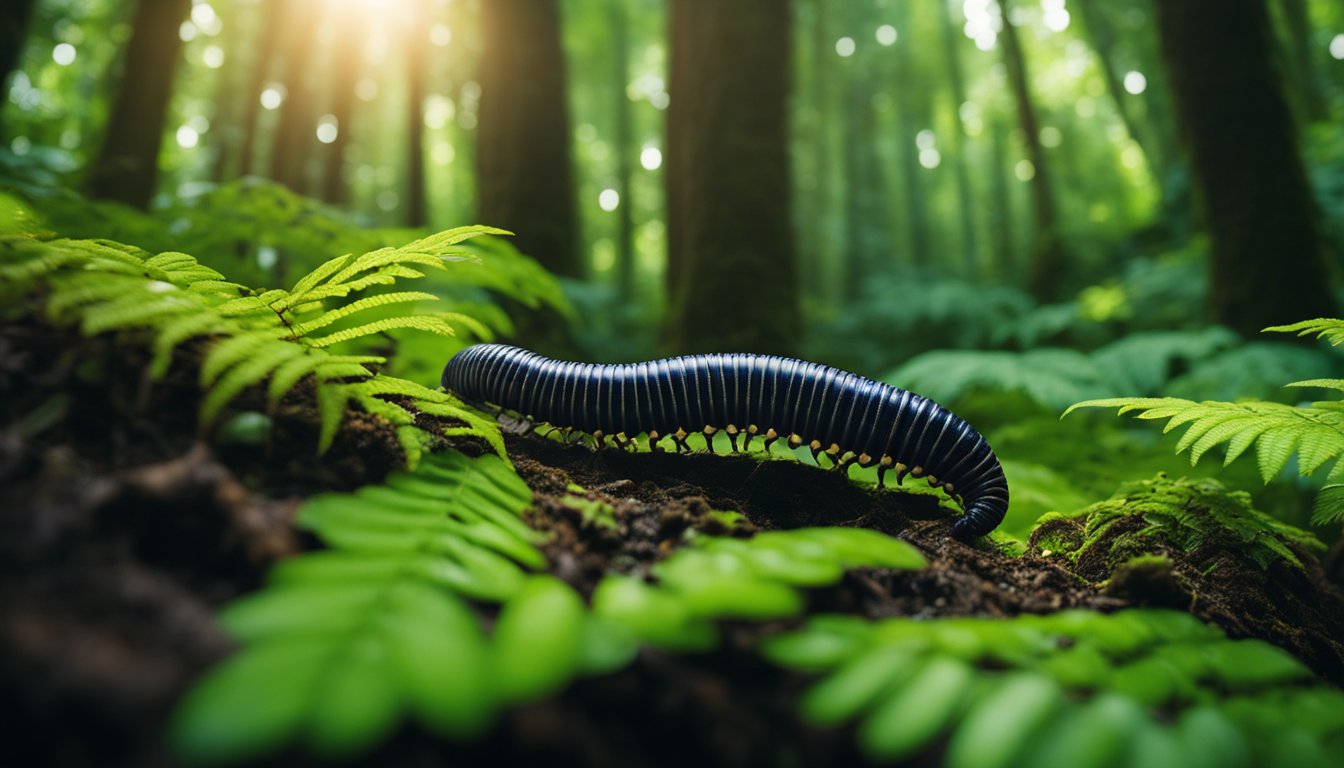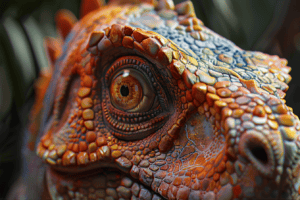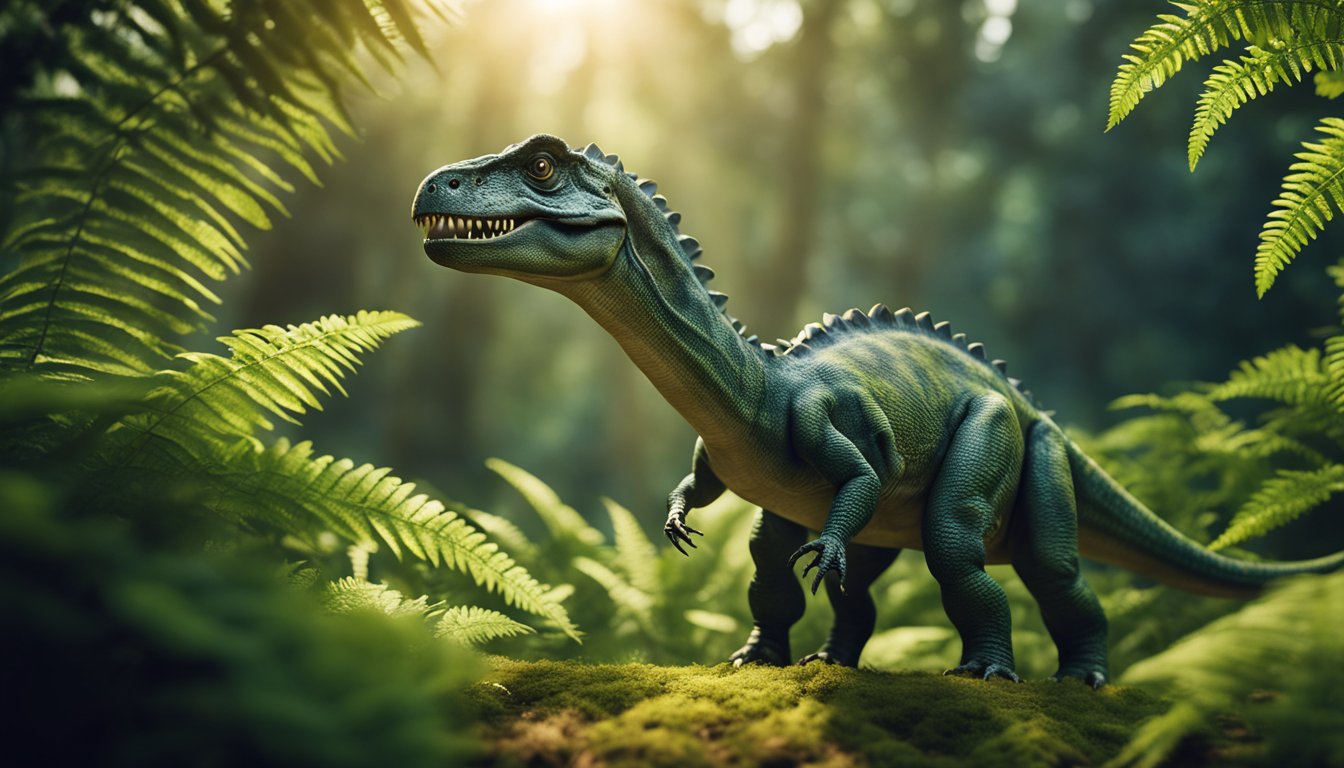Arthropleura, the giant millipede of the Carboniferous period, was one of the largest invertebrates to have ever lived.
It roamed the lush forests of ancient England, and its enormous size was a wonder to behold.
Imagine a creature as big as a car, creeping along the forest floor, with hundreds of legs propelling it forward.
Arthropleura was a true giant of its time.

Despite its intimidating size, Arthropleura was a herbivore, feasting on plants and leaves.
Its size was likely a defense mechanism, deterring predators from attacking it.
Scientists have long been fascinated by Arthropleura, and recent fossil discoveries have shed new light on this prehistoric creature.
With each new discovery, we learn more about its anatomy, behavior, and habitat.
Unearthing the Arthropleura

Fossil Discoveries
Arthropleura is a genus of giant millipedes that lived during the Carboniferous period, about 300 million years ago.
These creatures were massive, with some individuals growing up to 2.5 meters (8 feet) in length.
They had a flat, segmented body covered by a hard exoskeleton, which protected them from predators and environmental hazards.
Fossils of Arthropleura have been found in various locations around the world, including Northumberland in England, where the largest-ever fossil of this creature was discovered.
The fossil was found by a researcher named Neil Davies on a beach in Northumberland, and it is estimated to be about 326 million years old.
The fossil was preserved in sandstone cliffs, which were once part of a river channel that flowed through an open woodland environment.
The discovery of the Arthropleura fossil has shed light on the behavior and habitat of these giant millipedes.
Scientists believe that Arthropleura lived in coal swamps and fed on decaying plant matter.
They also think that these creatures may have been semi-aquatic, spending much of their time in or near water.
Arthropleura’s Habitat
Arthropleura lived in a world very different from our own.
During the Carboniferous period, the Earth’s climate was much warmer and wetter than it is today.
The atmosphere was rich in oxygen, which allowed giant insects and other arthropods to thrive.
Arthropleura lived in a variety of habitats, including open woodlands, river channels, and coal swamps.
These environments provided the perfect conditions for these creatures to grow and thrive.
The open woodlands provided a source of food, while the river channels and coal swamps provided the moist environment that these creatures needed to survive.
In conclusion, the discovery of the Arthropleura fossil has given us a glimpse into a world that existed millions of years ago.
These giant millipedes were fascinating creatures that played an important role in the ecosystem of their time.
Through the study of fossils and other evidence, scientists are able to piece together the story of these ancient creatures and learn more about the world they lived in.
The Life of a Giant Millipede
Physical Characteristics
Arthropleura, the largest known terrestrial arthropod, was a giant millipede that roamed the Carboniferous forests over 300 million years ago.
It was a massive creature that could grow up to 2.6 meters long and 50 centimeters wide, with a segmented exoskeleton made up of over 30 articulated segments.
The exoskeleton was made of chitin, a strong and lightweight polymer that provided protection and support to the millipede’s soft internal organs.
The carapace of the exoskeleton was covered in small, bumpy plates that helped it grip the forest floor and climb over obstacles.
Diet and Behavior
Arthropleura was a herbivore, feeding on ferns, club mosses, and other nutritious nuts and seeds found in the Carboniferous forests.
It used its powerful jaws to crush and grind its food, and its many legs to move around the forest floor.
Despite its impressive size, Arthropleura was a relatively slow-moving creature, relying on its tough exoskeleton for protection from predators.
Arthropleura lived in a time when the Earth was dominated by invertebrates, such as giant millipedes, spiders, and scorpions.
It coexisted with amphibians and early reptiles, which were just beginning to evolve.
Arthropleura’s size and strength made it a formidable predator, but it was also vulnerable to larger invertebrates and vertebrates.
In conclusion, Arthropleura was a fascinating creature that provides a glimpse into the diverse and complex ecosystems of the Carboniferous period.
Its massive size, articulated exoskeleton segments, and nutritious diet make it a unique and important part of Earth’s natural history.
Extinction and Legacy

The End of an Era
Despite being the largest-known invertebrate animal of all time, Arthropleura did not survive the Permian extinction event, which wiped out approximately 96% of all marine species and 70% of all terrestrial species.
This mass extinction marked the end of the Paleozoic Era and the beginning of the Mesozoic Era.
Arthropleura’s extinction was likely due to a combination of factors, including the changing climate and atmospheric oxygen levels, as well as competition from other herbivores.
The Permian period, which lasted from 299 to 251 million years ago, was marked by a series of environmental changes, including several glaciation events, volcanic eruptions, and fluctuations in sea level.
These changes likely had a significant impact on the flora and fauna of the time, including Arthropleura.
Arthropleura’s Impact
Despite its extinction, Arthropleura has left a lasting legacy in the scientific community.
Its discovery and study have contributed to our understanding of evolution, ecology, and the history of life on Earth.
Arthropleura’s size and morphology have also inspired many works of art and fiction, including the sea scorpion and eurypterid, which were contemporaries of Arthropleura in the Carboniferous period.
Moreover, the discovery of Arthropleura’s fossilized remains has provided valuable insights into the ancient ecosystems of northern England and the wider Carboniferous forest.
The University of Cambridge’s recent discovery of the largest-ever fossil of a giant millipede, as big as a car, has reignited interest in Arthropleura and its place in the natural world.
Fun Fact: Arthropleura’s size and armor may have served as protection against predators, such as early amphibians and reptiles.
Its exoskeleton was made of calcium carbonate, which is similar to the shells of modern-day crustaceans and mollusks.
Frequently Asked Questions

How big did Arthropleura get during the Carboniferous period?
Arthropleura was a giant millipede that lived during the Carboniferous period, around 300 million years ago.
It was one of the largest land animals of all time, and some individuals are estimated to have grown up to 2.6 meters (8.5 feet) long.
That’s longer than a car!
What did Arthropleura typically eat?
Arthropleura was a herbivore, which means it ate plants.
It had strong jaws and sharp teeth that it used to crush and grind tough plant material, such as ferns and horsetails.
Scientists believe that Arthropleura may have also been a scavenger, feeding on dead animals.
Can you find Arthropleura fossils today, and if so, where?
Yes, you can find Arthropleura fossils today, but they are rare.
Most of the fossils that have been found were discovered in Europe and North America, in rocks that date back to the Carboniferous period.
Arthropleura fossils are usually found in coal mines or other sedimentary rocks that formed in swamps and wetlands.
What are some theories about why Arthropleura went extinct?
There are several theories about why Arthropleura went extinct.
One theory is that the changing climate during the late Carboniferous period made their habitat less suitable for their survival.
Another theory is that the evolution of new predators, such as amphibians and reptiles, may have contributed to their decline.
How does Arthropleura compare to modern-day millipedes and centipedes?
Arthropleura was much larger than modern-day millipedes and centipedes.
Millipedes and centipedes alive today are typically only a few centimeters long, while Arthropleura could grow up to several meters in length.
Additionally, Arthropleura had a different body structure than modern-day millipedes and centipedes, with a flatter body and legs that were arranged in a different way.
What kind of environment did Arthropleura live in during the Carboniferous?
Arthropleura lived in a warm and humid environment during the Carboniferous period.
This was a time when much of the Earth’s land was covered in dense forests of ferns and other plants.
Arthropleura lived in these forests, feeding on the abundant plant life and hiding from predators.







